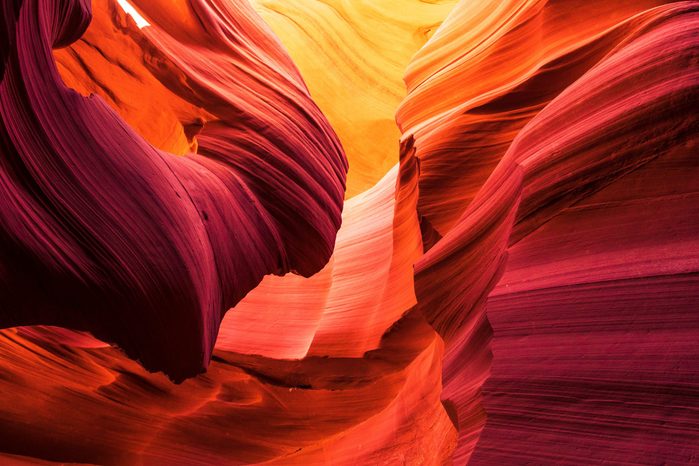
Stunning sights
During this time when we’re all cooped up indoors due to COVID-19 and can’t physically explore beautiful places, one of the ways to find comfort is looking at beautiful places. And thanks to the Internet, we can do that with ease! But instead of showcasing (albeit gorgeous) spots you’ve probably seen tons of times, these 15 images show lesser-known places whose beauty deserves more notoriety. Plus, check out these jaw-dropping photos of the world’s most beautiful countries.
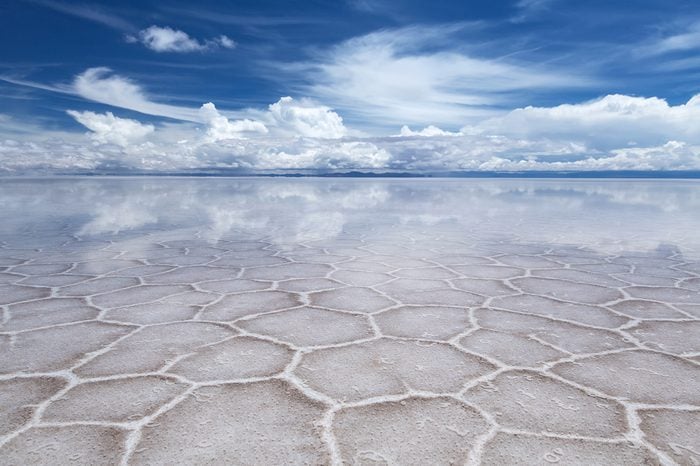
Salt flats of Uyuni, Bolivia
From lakes to deserts, Bolivia offers many natural wonders, including the world’s largest salt flat. Set in the southwestern part of the country, the Salar de Uyuni delivers 4,086 square miles of glistening white salt. “Few American travelers ever get to Bolivia, opting for more popular Peru, Chile, and Argentina,” says Rebecca Rhyan, destination specialist, Latin America, for Cox and Kings. “The salt flats are an other-worldly landscape for anyone who enjoys a bit of adventure.” Although the topography is mostly flat, the destination sits on the Altiplano at 11,995 feet above sea level; expect chilly temperatures when the sun goes down.
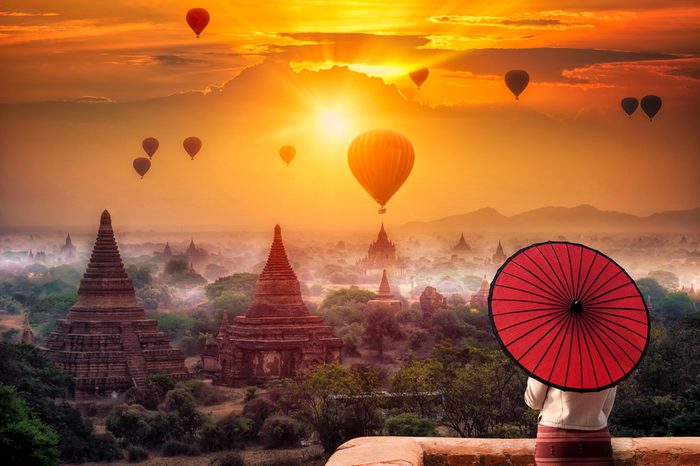
Bagan, Myanmar (Burma)
One of the richest archaeological sites in Asia, Bagan (also referred to as Pagan) is home to a collection of more than 2,200 temples, stupas, and pagodas. The collection represents a scenic tribute to the religious history and devotion of the settlers of Myanmar over the centuries; some temples, such as the graceful circular Shwesandaw Pagoda built by King Anawrahta, date back to 1057. The Buddhist culture in Burma is among the most authentic in any Southeast Asian nation. You also won’t believe these photos of earth’s most stunningly colorful natural wonders.
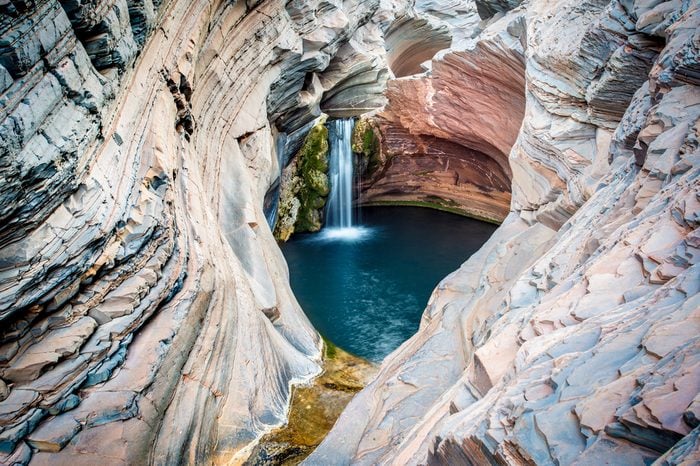
Karijini National Park, Australia
Known as the Grand Canyon of Australia, Karijini National Park in Australia’s Pilbari region on the west coast is the country’s second largest park, offering more than 2,400 square miles of mountains and escarpments rising from flat valleys, rocky water pools, waterfalls, and unique wildlife like red kangaroos and rock wallabies. While the water of the gorges and pools can be alarmingly cold, summer temperatures in the desert environment can soar to more than 100 degrees.
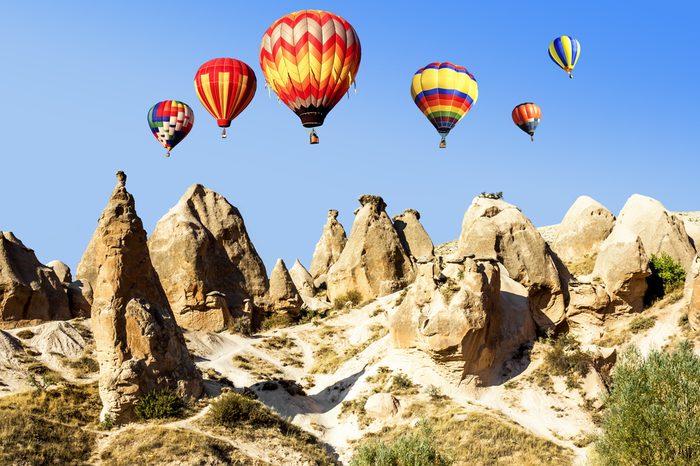
Capadoccia, Turkey
Set on a high plateau in Turkey’s central Anatolia region, Capadoccia, a UNESCO World Heritage site, is known for its unique moon-like landscape and mushroom-like volcanic rock sculptures, known as fairy chimneys. Settlement of the area dates back to the Paleolithic era. During the reign of the Roman Empire, Christians used the area as a place of escape, building homes and churches into the caves and rocks. “Capadoccia and its almost moon-like surface is unlike anywhere on Earth,” says Dania Weinstein, destination specialist, Africa and the Middle East for Cox and Kings.

Magnetic Hill, Ladakh, India
Located in the Indian state of Jammu and Kashmir that extends from the Kunlun mountain range to the Himalayas, Ladakh is a remote high desert valley known for historic medieval temples, Buddhist monasteries, and rugged terrain. It’s also home to Magnetic Hill, a gravity-defying phenomenon. Located at an elevation of 14,000 feet, Magnetic Hill and its surrounding topography produces the optical illusion that a slight downhill slope appears to be an uphill slope—and a vehicle left out of gear will appear to be rolling uphill. The optical illusion is attributed to an obstructed horizon. “Magnetic Hill can really play tricks with your eyes,” says Seema Prakash, senior destination specialist, India for Cox and Kings.
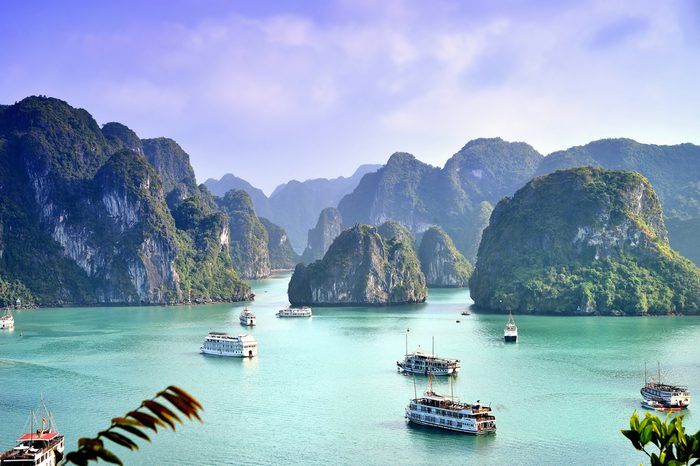
Ha Long Bay, Vietnam
The UNESCO World Heritage site, also known as “Descending Dragon Bay,” is an ethereal and scenic mix of more than 3,000 limestone karsts and isles jutting out from an emerald sea. The biodiverse bay is home to numerous marine and land animals, as well as 14 endemic floral species and 60 endemic fauna species. “The limestone karsts rise right from the water, and the destination is home to lots of wildlife, like cheeky monkeys,” says Bernal. Get a look at some more of the most remote spots on Earth.
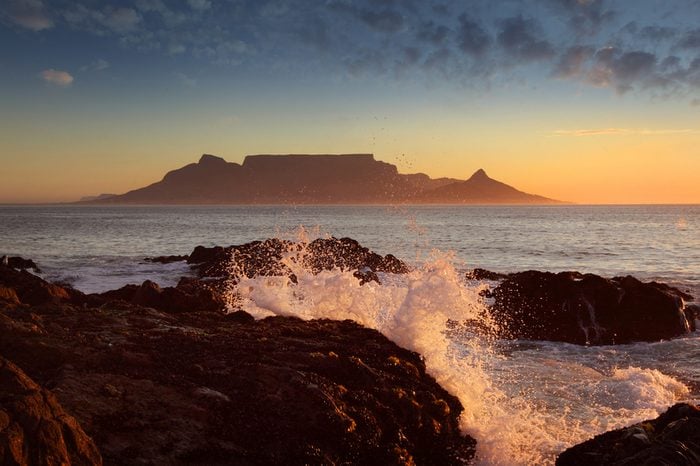
Table Mountain, South Africa
South Africa’s Cable Mountain is a 3,558-foot historic peak with rocks that are more than 600 million years old and a system of rare sandstone caves. More than 70 percent of the plants found on the mountain are endemic. It’s also home to the “dassie,” or rock hyrax, and 22 species of snakes, including the five most venomous: cape cobra, puff adder, boomslag, rinkhals, and berg adder. “Table Mountain looms over Capetown,” says Danalee May, senior destination specialist, Africa for Cox and Kings. Check out these incredible sunset photos from all across America.
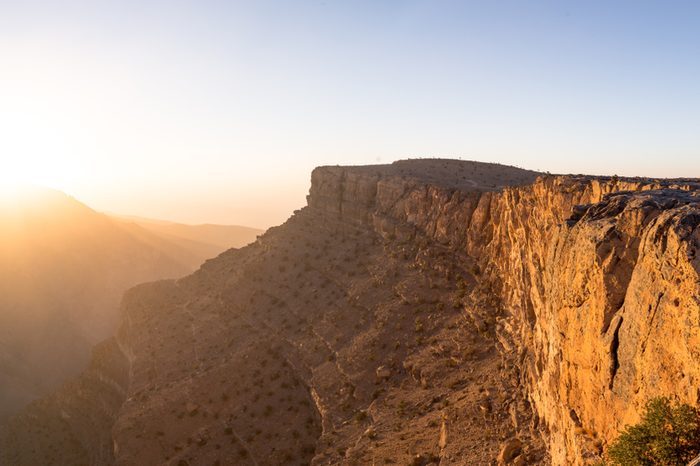
Wadi Nakhar, Oman
Known as the Grand Canyon of Oman, this remote valley located on Oman’s highest mountain, Jebel Shams (mountain of sun) in the Al Hajar mountain range. This rugged terrain boasts extremely rare plant life and a body of water so blue, it mirrors the sky on some days. “On the outer rim, there is a narrow access point that leads to the Balcony Walk—a 50-foot wide ledge, perched in the middle of the canyon, running about three miles long and leading to an abandoned village,” says Nathan Lane, Oman region manager, Butterfield & Robinson.
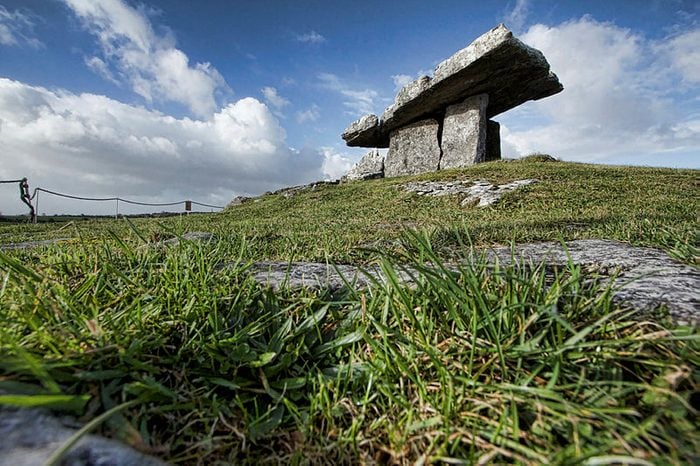
The Burren, Ireland
Set in County Clare in southwest Ireland, the Burren region is home to one of the most extensive areas of limestone pavement in Europe, a rare global land form. The vast windswept landscape features a cracked pavement of glacial-era gray limestone, dramatic cliffs and caves, lakes, rock formations, and archaeological sites. During the spring, the Burren showcases 75 percent of Ireland’s wildflowers, offering a colorful contrast to the stark beauty of the lunar-like landscape. “It does not stop at the geology and the botany,” says Tony Kirby of Heart of Burren Walks. “The region is a memorial to bygone cultures with over 2,000 archaeological monuments in the 200 square miles.” For more beauty from the British Isles, here are 17 stunning photos of Scotland.
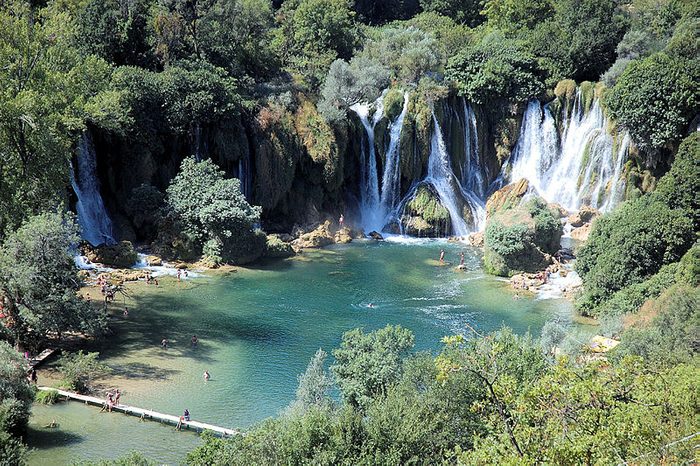
Kravica Waterfalls, Bosnia
Hidden in Europe’s last jungle along Bosnia’s Trebižat River is a series of waterfalls that could pass for the little sister of Niagara Falls. “The entire area is exceptionally green with chaste trees, poplars, and figs,” says Samer Hajric, Exodus mountain guide and program coordinator. “The rock and tuff formations host thick lichen, moss, and grass, giving them an emerald color—there are hardly any man made formations near the falls to interfere with the natural environment.” While the Kravice waterfalls are not big in terms of size, they are comparable to Krka or Plitvice National Parks in Croatia, but are less busy, explains Hajric.
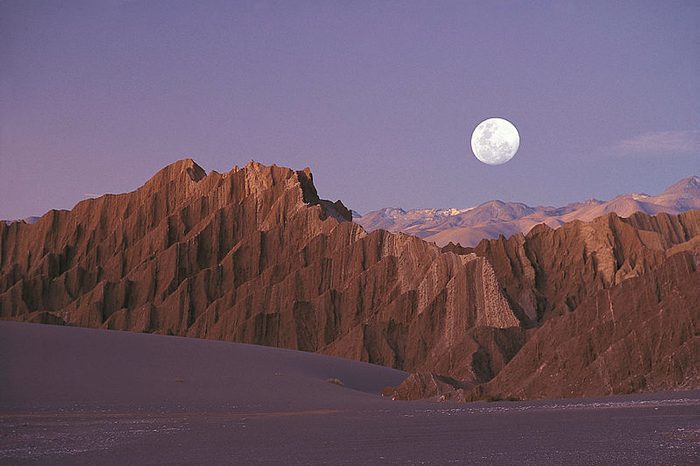
Valley of the Moon, Chile
Located in Los Flamencos National Reserve in northern Chile’s Atacama Desert, Valle de la Luna (valley of the moon) is one of the country’s most unique locations. The shimmering sand dunes and moon-like sculptures make for a dramatic landscape. “No other place in the world can be compared to this one, with no water, no fauna, and no flora,” says Malcolm Parkinson, Exodus Latin America product manager. “There are salt flats, geysers, altiplanic lagoons, and volcanoes,” says Parkinson.
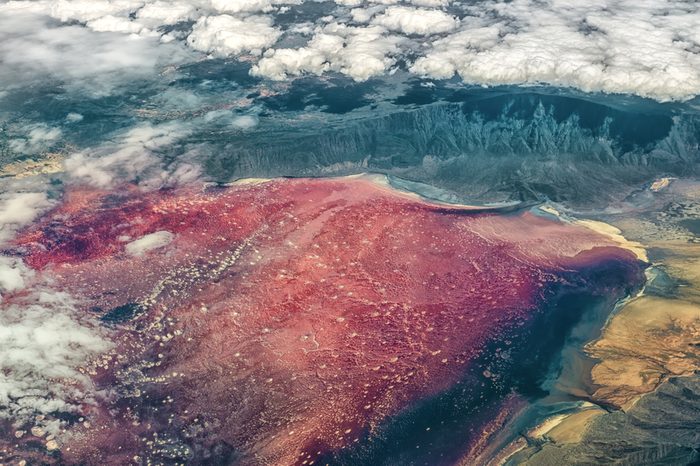
Lake Natron, Tanzania
This serene-looking lake set in northern Tanzania is so corrosive that it is believed the water can burn the skin and eyes of animals that are not adapted to it, turning them into mummies. The water alkalinity comes from the sodium carbonate and other minerals that flow into the lake from the surrounding hills as well as from the mineral rich hot springs that feed the lake. Shallow (less than ten feet) but vast (35 miles long), Lake Natron boasts an average temperature of 104 degrees and an abundance of cyanobacteria, a bacterium with red pigment, which gives the lake its characteristic red and orange glow. Despite its saltiness, the lake is home to a thriving ecosystem and serves as a breeding ground for about 2.5 million Lesser flamingos (a species of flamingos) who thrive on the cyanobacteria. Check out these other stunning naturally pink beaches around the world.
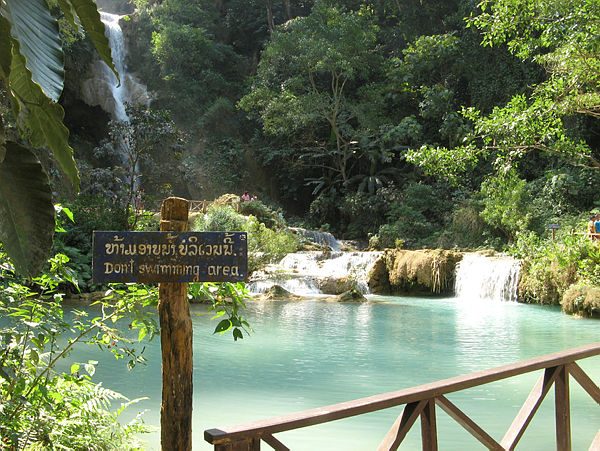
Kwang Si Falls, Laos
Kwang Si Falls is a three-level waterfall about 18 miles south of the ancient capital of Luang Prabang. Vibrant blue water flows down the falls through a series of pools, smaller at the top and widening as the water falls into the jungle river. “Northern Laos offers natural beauty with meandering rivers flanked by jungle-clad hills and karst mountains,” says Tom Harari, Exodus’ Senior Product Manager and former Laos guide. “While not as grand as Iguazu or Victoria Falls, the park is a serene place that combines falls and cascades, a green jungle, and turquoise pools.” Don’t miss these breathtaking photos of natural pools.
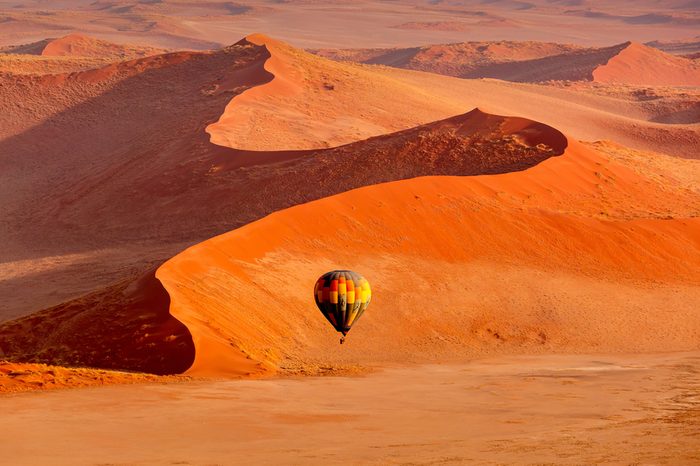
Sossusvlei, Namibia
Sossusvlei, which translates to “dead-end marsh,” is set in Africa’s largest conservation area, the Namib-Naukluft National Park. Characterised by the large red dunes that surround it, Sossusvlei is a vast, white salt and clay pan with dunes that reach more than 1,200 feet high. While the area remains dry most years, any unusually rainy seasons turn the pan into a glassy lake, reflecting the surrounding dunes. “From the timeless sand rippling across towering dunes to the skeleton trees of Deadvlei (one of Sossusvlei’s most popular pans), Sossusvlei is captivating,” says Michele Harvey, Southern Africa region manager, Butterfield & Robinson.
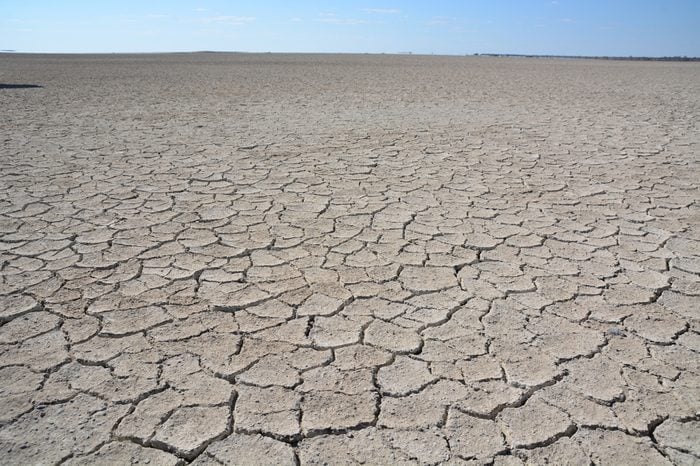
Makgadikgadi Pan, Botswana
The Makgadikgadi Pan, a salt pan set in the middle of the dry savanna of northeastern Botswana, is one of the largest salt flats in the world. Actually a collection of several pans surrounded and intersected by the Kalahari Desert, Makgadikgadi Pan extends across 6,200 square miles all within the Kalahari Basin. As a remnant of the now dried up Lake Makgadikgadi, the pan is dry, salty clay much of the year, but during years of abundant rain, some of the pans flood, becoming grassy plains and attracting wildlife such as zebra and wildebeest as well as flamingos, which flock to the Nata Sanctuary by the thousands. “The experience of the Makgadikgadi Pan is one of vastness,” says Harvey. Next, pretend you’re at the beach with these breathtaking wave photos you won’t believe are real.